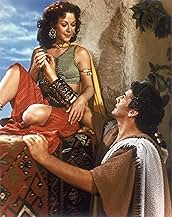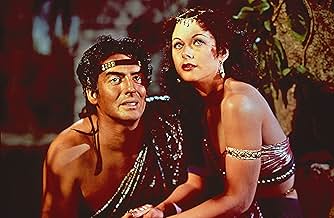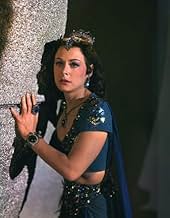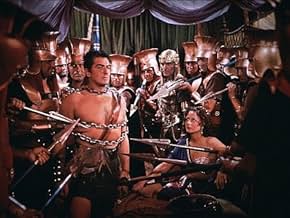NOTE IMDb
6,8/10
9,5 k
MA NOTE
L'epopee biblique et tragique de Samson, qui lutte pour liberer son peuple, les Hebreux soumis aux Philistins. Il tombera dans le piege tendu par la belle et cruelle Dalila.L'epopee biblique et tragique de Samson, qui lutte pour liberer son peuple, les Hebreux soumis aux Philistins. Il tombera dans le piege tendu par la belle et cruelle Dalila.L'epopee biblique et tragique de Samson, qui lutte pour liberer son peuple, les Hebreux soumis aux Philistins. Il tombera dans le piege tendu par la belle et cruelle Dalila.
- Réalisation
- Scénario
- Casting principal
- Récompensé par 2 Oscars
- 7 victoires et 5 nominations au total
Russ Tamblyn
- Saul
- (as Russell Tamblyn)
Francis McDonald
- Story Teller
- (as Francis J. McDonald)
William 'Wee Willie' Davis
- Garmiskar
- (as William Davis)
Kasey Rogers
- Spectator
- (as Laura Elliot)
Avis à la une
While having some very major flaws, this is a thoroughly decent biblical epic on the story of Samson and Delilah. It is nicely filmed, with lovely costumes, nice sets and good cinematography and has a rousing score. Also the acing is not bad at all, Victor Mature is a dashing Samson and Hedy Lamarr pretty much steals the film as the beautifully captivating Delilah, it somehow reminded me of Rita Hayworth in Salome. George Sanders proves here he is the epitome of calculation and world-weariness, and while Angela Lansbury is good she has been better. Plus the final scene with the temple coming down is brilliantly staged and serves as the highlight of the film. However, the script is not always that great, neither is the pacing which is quite slow or the direction which is disappointingly stodgy. Overall though, Samson and Delilah isn't bad, it could've been better, but it was decent. 7/10 Bethany Cox
Yeah...so some people may think it's corny and outdated. However, there is something about this movie, in spite of some of the poorer technical gimmicks...yet I still love it. I think that Lamarr does a great job as Delilah and don't understand why some think otherwise.I think she is/was the perfect Delilah..and Mature did a great job as Samson. Sanders was really terrific in his role and Lansbury carried out her part very well also. Call it what you will..but I find it is still worth watching; the color, costumes, Samson knocking down the Temple.. (love that scene!Good special effects for the time.) Whatever it is..I find myself watching it every now and then and still enjoy it as much as when I first saw it..
I've always loved this film. Granted, somehow it does not generate the 'huge epic' feel of some of the director's other work but it is a great film to sit down and relax in front of. Opulent costume design, good casting and excellent cinematography make this one of the better biblical epics that were being produced at the time.
Victor Mature, a fine physical specimen of the male physique, seems to fit perfectly into the role of the brooding and oft-troubled Samson. Burt Lancaster, I'm told, was the original choice for the part which I think would have been a bad choice. Although Lancaster is a better actor, on purely aesthetic grounds, the Mediterranean featured, tousle-locked Mature fitted better into the location.
George Sanders is superb as the Saran of Gaza. One of the other reviewers on this website said he portrayed a "sophisticated cad" which is the best description I have ever heard of Mr Sanders in this role or any other for that matter.
The absolute star of the show is the movie's other lead actor, Hedy Lamarr. This was undoubtedly the finest hour of an actress who either, curiously passed up or was just overlooked for many other leading parts. Hedy sets the screen on fire as the sensual and wicked Delilah, playing with and dragging every man on screen and in the audience in her wake. Many have questioned her acting ability. Truth is I doubt we shall ever really find out. Poor choice of scripts and directors resulted in her being pushed to the sidelines at MGM and eventually and sadly into complete obscurity.
Victor Mature, a fine physical specimen of the male physique, seems to fit perfectly into the role of the brooding and oft-troubled Samson. Burt Lancaster, I'm told, was the original choice for the part which I think would have been a bad choice. Although Lancaster is a better actor, on purely aesthetic grounds, the Mediterranean featured, tousle-locked Mature fitted better into the location.
George Sanders is superb as the Saran of Gaza. One of the other reviewers on this website said he portrayed a "sophisticated cad" which is the best description I have ever heard of Mr Sanders in this role or any other for that matter.
The absolute star of the show is the movie's other lead actor, Hedy Lamarr. This was undoubtedly the finest hour of an actress who either, curiously passed up or was just overlooked for many other leading parts. Hedy sets the screen on fire as the sensual and wicked Delilah, playing with and dragging every man on screen and in the audience in her wake. Many have questioned her acting ability. Truth is I doubt we shall ever really find out. Poor choice of scripts and directors resulted in her being pushed to the sidelines at MGM and eventually and sadly into complete obscurity.
In 1949, I was 11years old and saw it in NYC when it was first released. My aunt Ethel, may she rest in peace, took me during Christmas vacation. I was mesmerized by it which led me to check out the story in that Chapter of the O.T. called Judges. And I remember being asked by my 6th or 7th grade teacher to do an oral report about the film before the class. I found it a bit awkward to discuss the idea of seduction at that time especially when I heard the pubescent girls giggling. At any rate I did make that report and remember displaying the book I had bought about the film right at the theater. I estimate from age 11 to 14, I saw the film a dozen times and I'm not kidding. In my adulthood, I saw it once on free TV and rented it once for kicks. Quite honestly, I never saw a more beautiful woman than Hedy in that role. And Victor was perfect thanks to his countenance and physique. After seeing it first and then reading the story in the O.T. I came to the conclusion that the film certainly was factual and illuminating. The bible came alive thanks to the genius of Cecil B.DeMille. The special effects were brilliant, way ahead of its time. What I especially loved about this film was the haunting score by Victor Young and I do remember going out to buy it on 78 rpm disks. And I do have the radio program on cassette, "Lux Presents Hollywood-Samson and Delilah starring Mature and Lamarr. That last scene will always stick in my mind as Samson, standing blind between the two main pillars of the Temple of Dagon, the Phillistine God,called on Jehovah to give him the strength to crush his enemies and WHAT A SCENE FOLLOWED. Good heavens, DeMille was indeed a GENIUS! I recommend the film to EVERYONE because of the amazing story, color
Cecil B. DeMille is best remembered for his biblical epics, even though in a forty-year, eighty-film career he only made four of them. It wasn't just that the bible pictures gave him some of his biggest hits; it was in these features that DeMille seemed most at home, and the one genre in which he had unique ability.
Samson and Delilah brought an end to a long phase of epic-cum-adventure movies from DeMille. This period, beginning with The Plainsman in 1936, had some of the weakest pictures of his career for a number of reasons. For one thing, DeMille was not really very good at individualistic action scenes, and there was too much DeMillean historical grandeur and not enough of the free-spirited feel of the Errol Flynn or Tyrone power swashbucklers he was to some extent an trying to copy. What's more, these were mostly original stories or, at least, ones which were not well known, and DeMille's poor choice of source material and screenwriters meant the new characters and situations tended towards the feeble. DeMille's strength lay in his staging and presentation of a familiar tale, and as such his return to Sunday-school moralising, stuffy and pompous though it may be, is apt and welcome.
You see, DeMille was probably aware on some level that although these fables were well-known in a largely Christian society, to a modern audience they were also historically distant, emotionally neutral and even ridiculous when presented literally. But DeMille never attempted any humanity or realism in his features, instead turning the remote, mythical nature of the stories into a virtue, portraying his subject matter with a kind of dignity and grace. Of course most ancient world epics do this to some extent, but DeMille did it the most effectively because he never demanded that the audience sympathise with the characters, merely that we marvel at their deeds.
Specifically, DeMille composes the picture with overstated gesturing and painterly tableau, like a Gustave Dore print come to life. This is combined with the vivid colours of a bible stories illustration, coded with drab shades for humbleness and virtue, garish ones for extravagance and sin. Throughout, DeMille's flair for dreamlike, rhythmic motion keeps the images flowing, most notably in the establishing tracking shot at the wedding feast - although if you watch closely you'll see one of the two men engaged in a mock swordfight is actually camply slapping his opponent with a feather duster.
And DeMille was perhaps unique in that he even used the imagery to turn God into a character. You can see from one of his much earlier religious pictures, 1929's The Godless Girl, that DeMille associated God with natural beauty, and in Samson and Delilah God makes several key "appearances" as a breathtaking skyscape. This touch would be expanded upon in the 1956 version of Ten Commandments.
It's a pity DeMille didn't associate God with good acting, because even the theatrical presentation on offer here could do with at least some half-decent hamming. The trouble is DeMille chose his actors for their physicality, not for their ability to qualify their job description. In this respect Victor Mature and Hedy Lamarr are natural choices. DeMille's business associate Henry Wilcoxon, whom the director unbelievably used to cast in lead roles, is as wooden as ever, and the somewhat hit-and-miss Angela Lansbury, misses this time. The only standout is George Sanders who proves, just as Herbert Marshall did in DeMille's Four Frightened People, that bad dialogue becomes bearable if you underplay it.
Fortunately when it came to crew DeMille always procured the best. Samson and Delilah boasts Oscar-winning costumes and art direction from no less personages than Edith Head and Hans Dreier respectively. The Technicolor cinematography is great, with some remarkably clear night time shots. Some of the effects may be a little dubious; whenever Victor Mature lifts up something heavy it's obvious it's being hoisted from offscreen, and that woolly-rug/lion tamer scene is actually betrayed by bad editing, but overall this is a solid, high-quality production.
Yes, Samson and Delilah is as corny as anything, but it looks great, and above all it entertains. Don't be too harsh on DeMille's staginess or his archaic moralism, for as his willing appearance as himself in Sunset Boulevard proves, he probably didn't have a sense of irony. And his earnestness was probably his greatest asset.
Samson and Delilah brought an end to a long phase of epic-cum-adventure movies from DeMille. This period, beginning with The Plainsman in 1936, had some of the weakest pictures of his career for a number of reasons. For one thing, DeMille was not really very good at individualistic action scenes, and there was too much DeMillean historical grandeur and not enough of the free-spirited feel of the Errol Flynn or Tyrone power swashbucklers he was to some extent an trying to copy. What's more, these were mostly original stories or, at least, ones which were not well known, and DeMille's poor choice of source material and screenwriters meant the new characters and situations tended towards the feeble. DeMille's strength lay in his staging and presentation of a familiar tale, and as such his return to Sunday-school moralising, stuffy and pompous though it may be, is apt and welcome.
You see, DeMille was probably aware on some level that although these fables were well-known in a largely Christian society, to a modern audience they were also historically distant, emotionally neutral and even ridiculous when presented literally. But DeMille never attempted any humanity or realism in his features, instead turning the remote, mythical nature of the stories into a virtue, portraying his subject matter with a kind of dignity and grace. Of course most ancient world epics do this to some extent, but DeMille did it the most effectively because he never demanded that the audience sympathise with the characters, merely that we marvel at their deeds.
Specifically, DeMille composes the picture with overstated gesturing and painterly tableau, like a Gustave Dore print come to life. This is combined with the vivid colours of a bible stories illustration, coded with drab shades for humbleness and virtue, garish ones for extravagance and sin. Throughout, DeMille's flair for dreamlike, rhythmic motion keeps the images flowing, most notably in the establishing tracking shot at the wedding feast - although if you watch closely you'll see one of the two men engaged in a mock swordfight is actually camply slapping his opponent with a feather duster.
And DeMille was perhaps unique in that he even used the imagery to turn God into a character. You can see from one of his much earlier religious pictures, 1929's The Godless Girl, that DeMille associated God with natural beauty, and in Samson and Delilah God makes several key "appearances" as a breathtaking skyscape. This touch would be expanded upon in the 1956 version of Ten Commandments.
It's a pity DeMille didn't associate God with good acting, because even the theatrical presentation on offer here could do with at least some half-decent hamming. The trouble is DeMille chose his actors for their physicality, not for their ability to qualify their job description. In this respect Victor Mature and Hedy Lamarr are natural choices. DeMille's business associate Henry Wilcoxon, whom the director unbelievably used to cast in lead roles, is as wooden as ever, and the somewhat hit-and-miss Angela Lansbury, misses this time. The only standout is George Sanders who proves, just as Herbert Marshall did in DeMille's Four Frightened People, that bad dialogue becomes bearable if you underplay it.
Fortunately when it came to crew DeMille always procured the best. Samson and Delilah boasts Oscar-winning costumes and art direction from no less personages than Edith Head and Hans Dreier respectively. The Technicolor cinematography is great, with some remarkably clear night time shots. Some of the effects may be a little dubious; whenever Victor Mature lifts up something heavy it's obvious it's being hoisted from offscreen, and that woolly-rug/lion tamer scene is actually betrayed by bad editing, but overall this is a solid, high-quality production.
Yes, Samson and Delilah is as corny as anything, but it looks great, and above all it entertains. Don't be too harsh on DeMille's staginess or his archaic moralism, for as his willing appearance as himself in Sunset Boulevard proves, he probably didn't have a sense of irony. And his earnestness was probably his greatest asset.
Le saviez-vous
- AnecdotesFor the scene in which Samson kills the lion, Victor Mature refused to wrestle a tame movie lion. Told by Producer and Director Cecil B. DeMille that the lion had no teeth, Mature replied, "I don't want to be gummed to death, either." The scene shows a stuntman wrestling the tame lion, intercut with close-ups of Mature wrestling a lion skin.
- GaffesJust after Delilah rings for her servant to bring dinner, the mike boom casts a shadow on one of the curtain walls of her tent.
- Crédits fousAlthough the opening credits mention "Holy Land Photography," the second-unit location shooting occurred in North Africa (Algiers and Morocco), not Israel or the Middle East.
- Versions alternativesPrevious home media releases of the film (LaserDisc, VHS) did not include the overture and exit music. They were restored for Paramount's official DVD release in 2013 and the subsequent Blu-ray release in 2014.
- ConnexionsFeatured in History Brought to Life (1950)
Meilleurs choix
Connectez-vous pour évaluer et suivre la liste de favoris afin de recevoir des recommandations personnalisées
Détails
Box-office
- Budget
- 3 000 000 $US (estimé)
- Durée2 heures 14 minutes
- Couleur
- Rapport de forme
- 1.37 : 1
Contribuer à cette page
Suggérer une modification ou ajouter du contenu manquant

Lacune principale
By what name was Samson et Dalila (1949) officially released in India in Hindi?
Répondre






































